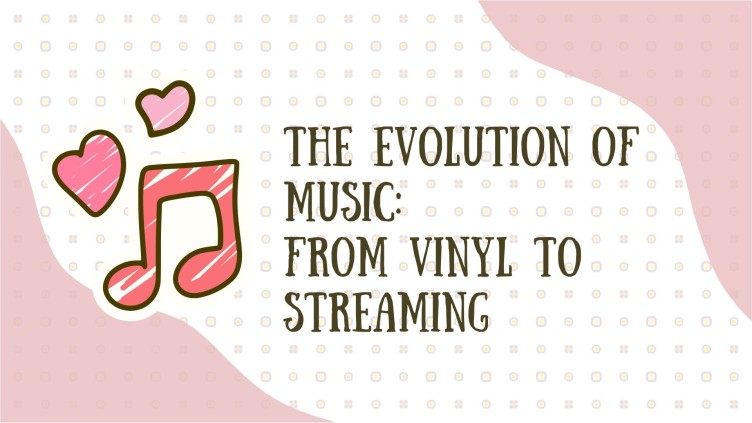Introduction
Music has been an integral part of human culture for millennia. From ancient instruments to the digital age, how we consume music has evolved dramatically. The journey from vinyl records to streaming services highlights not only technological advancements but also changes in how we interact with and appreciate music. In this comprehensive article, we’ll explore this evolution and its impact on our listening habits. For more insights into the world of music and its evolution, visit Riya’s Blogs.
The Golden Age of Vinyl Records
Birth of the Vinyl Era
In the late 1940s, vinyl records revolutionized the music industry. Unlike their shellac predecessors, vinyl records were more durable and offered better sound quality. This format quickly became the standard for music lovers worldwide.
The Cultural Impact
Vinyl records did more than just bring music into homes; they created a culture. Album art, liner notes, and the ritual of flipping through records in a store added layers to the music experience. Listening to music was an event, often shared with friends and family.
Collectibility and Sound Quality
Vinyl records are prized for their warm, rich sound. Audiophiles argue that the analog quality of vinyl captures nuances that digital formats miss. Collecting records became a passion for many, with rare editions fetching high prices.
The Rise of Magnetic Tape
The Cassette Revolution
In the 1960s, cassette tapes brought a new level of portability and convenience. Compact and easy to use, they allowed people to take their music on the go. The invention of the Walkman in 1979 further amplified this portability, changing how and where people listened to music.
The Mixtape Phenomenon
Cassettes also gave rise to the mixtape, allowing users to create personalized playlists. This was a significant cultural shift, enabling music lovers to curate their musical experiences and share them with others.
The Decline of Cassettes
Despite their popularity, cassettes had limitations. The sound quality was often inferior to vinyl, and tapes could easily degrade or become tangled. By the 1990s, CDs began to replace cassettes as the preferred format.
The Digital Age Begins: Compact Discs
Superior Sound and Durability
Compact Discs (CDs) were introduced in the early 1980s, offering superior sound quality and durability compared to cassettes and vinyl. They were less prone to wear and tear and could hold more music.
The CD Boom
The 1990s saw a massive boom in CD sales. With their sleek design and enhanced sound quality, CDs quickly became the dominant music format. The ability to skip tracks and the emergence of portable CD players added to their appeal.
The Decline of Physical Media
However, the physical nature of CDs also meant they were susceptible to scratches and required storage space. As digital technology advanced, CDs began to face competition from new, more convenient formats.
The Digital Revolution: MP3s and the Internet
The Birth of MP3
The late 1990s brought a seismic shift with the advent of MP3 files. These compressed digital audio files made it easy to store and share music online. The MP3 format reduced file sizes significantly without severely compromising sound quality.
The Rise of Napster
In 1999, Napster changed everything. As a peer-to-peer file-sharing service, it allowed users to share MP3 files freely. This democratized music access but also led to widespread piracy issues, fundamentally challenging the music industry’s business model.
The Legal Battles
The rise of MP3s and platforms like Napster triggered a series of legal battles. Record labels and artists fought against what they saw as the illegal distribution of their work. These conflicts eventually led to the shutdown of Napster in 2001 but also paved the way for legal digital music services.
The Streaming Era: Convenience and Access
The Birth of iTunes
In response to the challenges posed by piracy, Apple launched the iTunes Store in 2003. It provided a legal way to purchase and download music, with songs priced individually. The introduction of the iPod, a portable digital music player, further boosted the popularity of digital music.
Streaming Services Emerge
The next major shift came with the advent of streaming services. Platforms like Spotify, launched in 2008, offered vast music libraries accessible for a monthly subscription. This model emphasized access over ownership, fundamentally changing how people consumed music.
The Dominance of Streaming
Today, streaming services dominate the music industry. With millions of songs available at our fingertips, listeners can explore diverse genres and artists with ease. Algorithms and personalized playlists enhance the user experience, making music discovery more intuitive and enjoyable.
Impact on Artists and the Industry
Streaming has also reshaped the music industry’s economics. While it provides artists with a global platform, it has also led to debates about fair compensation. Streaming royalties are typically lower than physical sales or digital downloads, prompting discussions about the sustainability of this model for musicians.
The Future of Music Consumption
The Role of AI and Machine Learning
Artificial Intelligence (AI) and machine learning are set to play significant roles in the future of music. These technologies are already being used to curate personalized playlists, predict user preferences, and even create new music.
Virtual Reality and Immersive Experiences
Virtual Reality (VR) and Augmented Reality (AR) are poised to transform the concert experience. Imagine attending a live performance from the comfort of your home, with immersive visuals and surround sound enhancing the experience.
Continued Evolution
As technology advances, so will the ways we consume music. From high-fidelity streaming to innovative ways of discovering and interacting with music, the future promises exciting developments that will continue to enrich our musical experiences.
Conclusion
The evolution of music consumption from vinyl to streaming reflects broader technological and cultural shifts. Each era brought unique experiences and challenges, shaping how we interact with music today. As we look to the future, it’s clear that music will continue to evolve, driven by technological innovation and changing listener preferences.
For more insightful articles on music and its ever-evolving landscape, visit Riya’s Blogs. Stay tuned to explore the fascinating world of music and its rich history.







